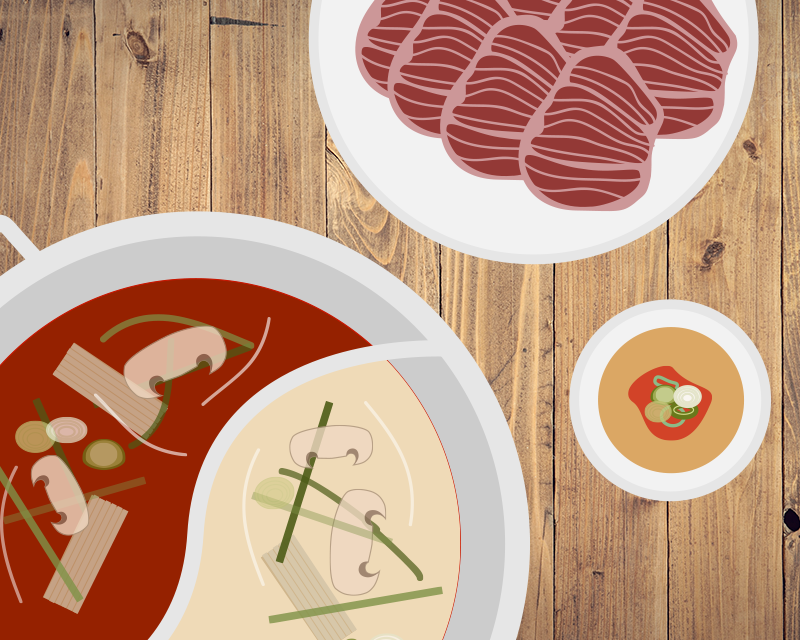By YOUNGSEO JHE, ANDREA KWON
Rating: ★★★★✩
Price: $
Andrea: ![]()
Youngseo: ![]()
A tower of toppings teetered on the table. Thin slices of meat were fanned out on a large plate, ready to be heated. A silvery metal pot split into two in the shape of yin and yang, boiling the two soups of different tastes. The contrasting hues of red and ivory captured our attention and the strong smell of seasoning stimulated our taste buds.
Although the exact origin of the Sichuan hotpot, also called huoguo, is unknown, many say huoguo was created during the Tang dynasty. However, it was only in the 1980s that huoguo became a popular traditional food. Over time, each region in China developed its own hotpot, the most famous being the Sichuan hotpot. Compared to other variations, Sichuan’s huoguo is usually divided into two parts: a section for white soup, a mild stew, and another for mala soup, a broth that generates a numbing spiciness in one’s mouth.
Lingling is an all-you-can-eat restaurant run by Chinese owners in Cheongdam-dong. Its most famous menu is the half-and-half hotpot. During our visit, we decided to try only the classic huoguo to focus our review on Lingling’s specialty dish. Upon placing our order, the server gave us the option of leaving out cilantro, which some people tend to dislike, from the huoguo.
The restaurant has a variety of items in its all-you-can-eat bar, ranging from vegetables, seafood, and meat to the classic toppings that go with dishes like tteokbokki. The extensive catalog of ingredients available at Lingling allowed us to try different combinations of toppings. Through multiple trials, we found that relatively bland vegetables paired nicely with the tangy mala stew, while the meat was perfect for the clear broth.
Following the traditional way of eating huoguo, we started off our tasting by adding some vegetables to both the mala and white soup. Lingling’s greens completely shattered the stereotype that restaurants with unlimited servings use cheap and low-quality ingredients. From the lettuce and bok choy to the wood-ear mushrooms, everything was fresh and crisp.
We then moved on to the meat. Lingling has an entire fridge filled with beef, pork, and lamb. We brought a small amount of each type of meat back to our table and distributed them evenly across the two soups. Again, it was evident that the restaurant’s meat was above standard quality. Our noses could barely detect the particular nauseating smell typical of red meat. Once the meat finished cooking, we retrieved it from the stew and lightly dipped it in the peanut sauce that our server had provided us with. The savory, nutty taste of the sauce augmented the satisfying taste of the tender meat and left us constantly craving for more.
Lingling does not disappoint those who find neither vegetables nor meat appetizing. The store provides its customers with a fridge of ingredients familiar to the Korean tongue, like eomuk (or fishcake), rice cake, glass noodles, and even mini wiener sausages. When thrown into the boiling huoguo, the toppings absorbed the deep taste of the vegetable-infused soup, filling our mouths with an enhanced richness. They provided us with a more sophisticated amalgamation of the ingredients you normally would find in a plate of spicy rice cakes. We praise Lingling for successfully preserving the original taste of Sichuan cuisine while also catering to the preferences of Korean customers.
For an all-you-can-eat restaurant with a plethora of quality ingredient choices, Lingling is relatively affordable. The hotpots are sold at a fixed price of ₩15,000 per person. One piece of information to keep in mind, however, is that the cost spikes to ₩25,000 if there is a significant amount of leftover food at your table. When you visit the eatery, remember to only take as much as you can eat from the topping bar.
Lingling’s costumer-oriented operation method transforms the store into one that will match your preferences regardless of whether you are a huoguo connoisseur or a stranger to Chinese cuisine. Your ₩15,000 will not go to waste at Lingling.

